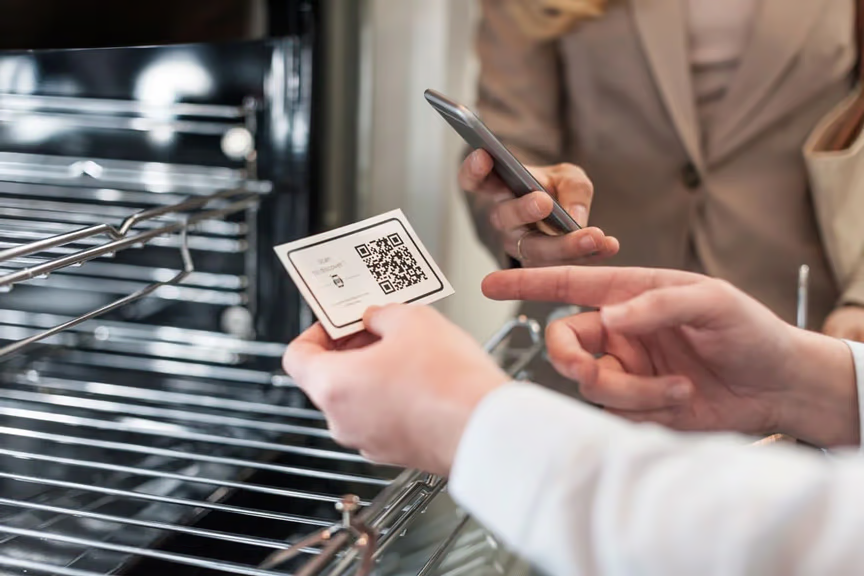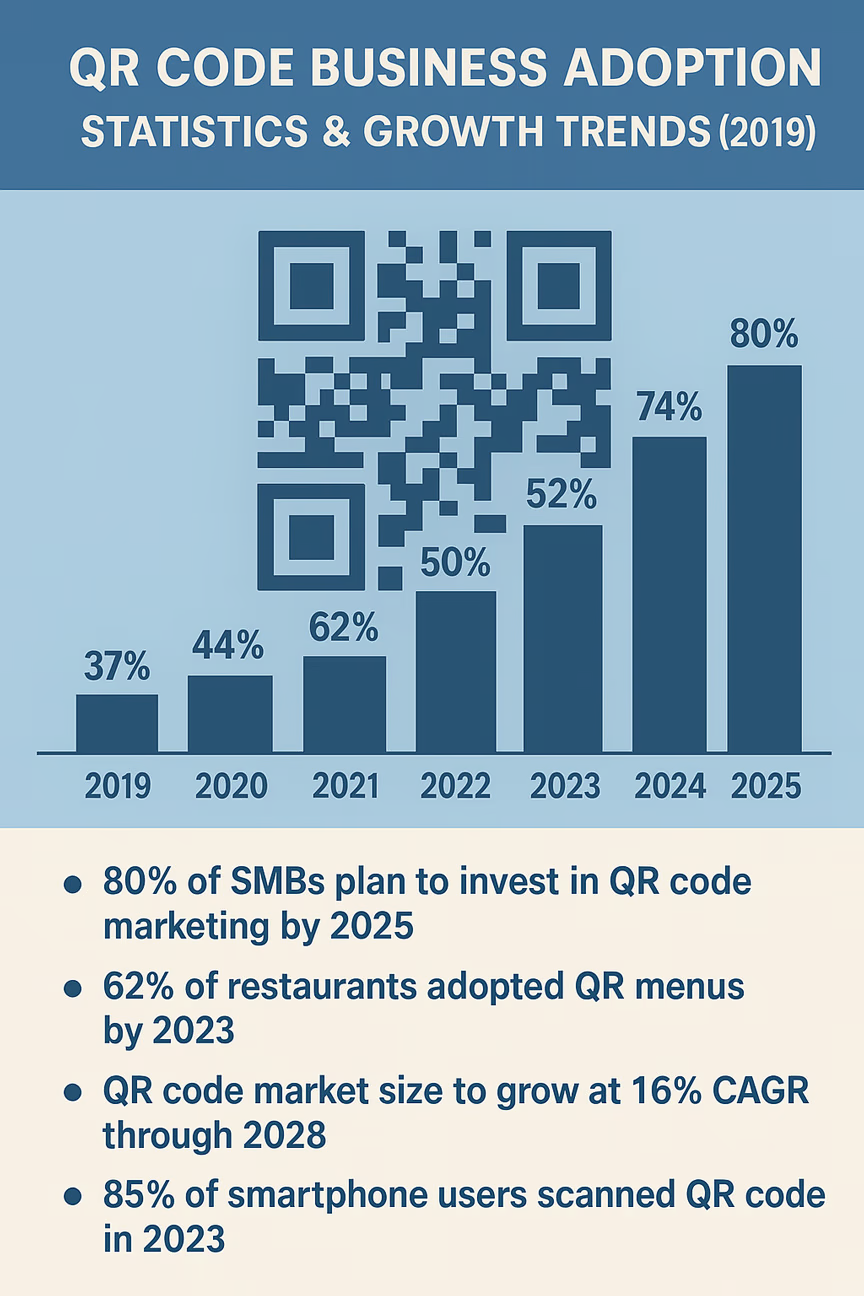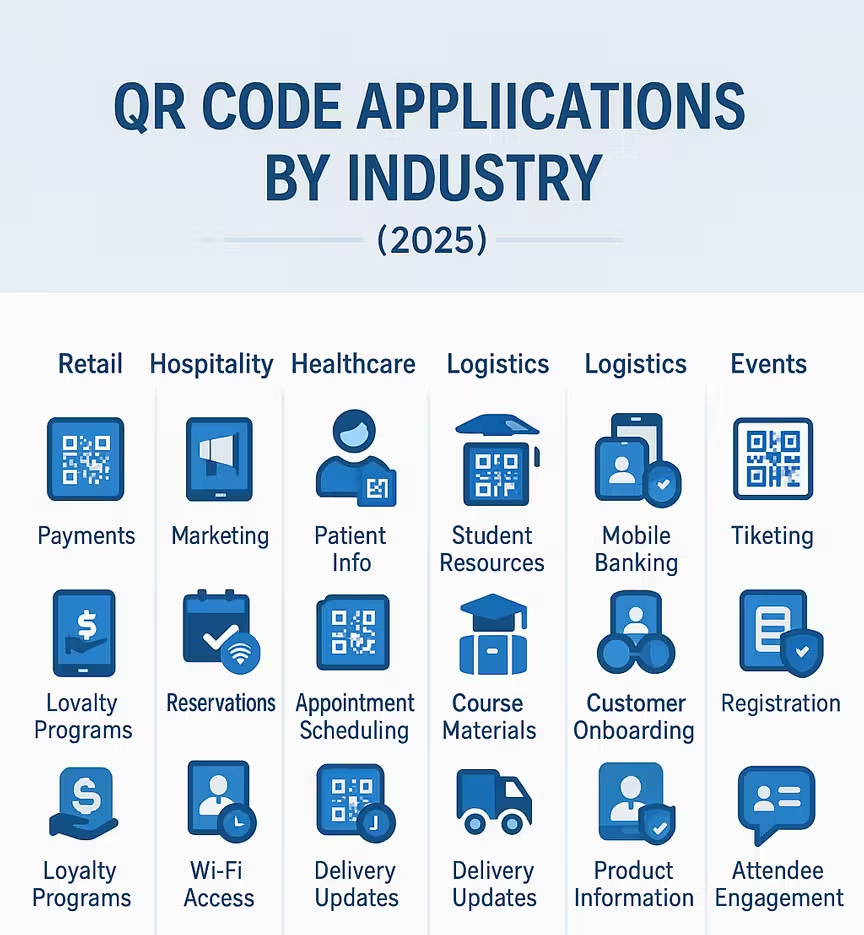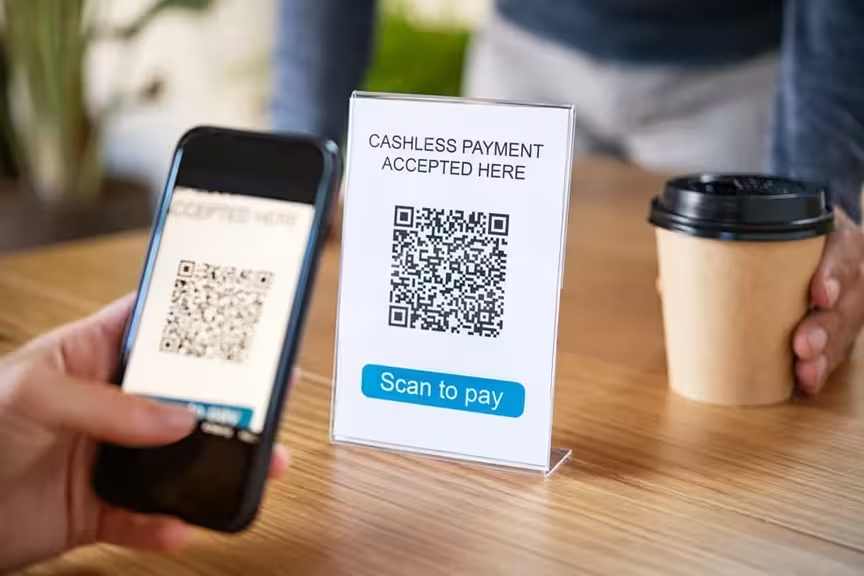
QR codes in business have become essential tools, with 95% of companies now using them to gather valuable customer data and 38% of small businesses creating QR codes to boost operations and sales. They're transforming how businesses connect with customers.
Running a business today means constantly looking for ways to make things easier for your customers while getting better results for yourself. You've probably noticed those black and white square codes popping up everywhere, from restaurant tables to product packages. There's a good reason for that.
QR codes have quietly become one of the most powerful business tools available. They're simple, affordable, and incredibly effective. While you might think they're just for tech companies, the truth is that businesses of all sizes, from local coffee shops to major corporations, are using them to solve real problems and increase profits.
Quick Answer: Why QR Codes Work for Business
QR codes work because they eliminate friction between your business and your customers. They provide instant access to information, payments, menus, and services while giving you valuable data about customer behavior and preferences.
- Why 95% of businesses now use QR codes for customer data (real statistics)
- 8 proven ways businesses use QR codes to increase sales and efficiency
- How small businesses see 28% more repeat customers with QR loyalty programs
- Step-by-step guide to implementing QR codes in your business
- Real case studies showing actual ROI and results
- Common mistakes that cost businesses money (and how to avoid them)
Ready to Create Your QR Code?
Join thousands of users who trust our platform for their QR Code needs. Start generating professional QR-Codes in seconds!
What Are QR Codes? (Business Owner's Guide)
QR stands for "Quick Response." Think of QR codes as super-powered barcodes that can hold much more information. While regular barcodes only work left-to-right, QR codes work in all directions, storing website links, contact information, payment details, or even entire digital business cards.
A Japanese company called Denso Wave invented them in 1994 to track car parts in factories. But smartphones turned them into something much more valuable for businesses. Now they can connect your physical business to the digital world instantly.
Here's why they matter for your business: Most phones made after 2017 can scan them automatically. No special app needed. This means your customers can access your information, make purchases, or connect with you in seconds, not minutes.
Why Businesses Love QR Codes: The Numbers Don't Lie
Let's talk real numbers. The QR code business market has exploded:
95% of businesses now gather valuable customer data through QR codes. This isn't just tracking, it's understanding your customers better.
43% of businesses use QR codes for logistics tracking, and 39% for inventory management. They're not just customer-facing tools.
Small businesses created 38% of all QR codes in 2023. You don't need to be a big corporation to benefit.
$12.54 billion was the global QR payment market in 2024, projected to reach $61.73 billion by 2033. That's serious money.
74% customer adoption rate for digital loyalty programs compared to just 30% for paper cards. Digital wins.
22% growth in QR code usage expected by 2025. This trend isn't slowing down.
The digital business card market alone is worth $181.46 billion in 2024 and growing to $389.3 billion by 2032. QR codes are driving this growth.
8 Proven Ways Businesses Use QR Codes
1. Customer Loyalty Programs
This is where QR codes really shine. Instead of carrying plastic cards that customers lose, businesses use QR codes for digital loyalty programs. The results are impressive: 74% of customers join digital programs compared to only 30% who use paper cards. One small business saw a 28% increase in repeat visits and 22% higher average order values among loyalty members.
2. Contactless Payments
The restaurant industry leads here. 88% of restaurant owners want contactless payment options, and QR codes make this possible. Customers scan a code to pay their bill, tip, and even provide feedback. The global QR payment market hit $12.54 billion in 2024 and restaurants account for 28.27% of that market.
3. Inventory and Logistics Management
43% of businesses use QR codes for logistics tracking. Each product gets a unique QR code that tracks its journey from warehouse to customer. Companies report up to 30% improvement in operational efficiency and 25% better warehouse operations when using QR codes for inventory management.
4. Digital Business Cards
Business networking has gone digital. QR codes on business cards instantly share contact information, social media profiles, websites, and portfolios. The digital business card market is worth $181.46 billion and growing 10.01% annually. No more typing contact information or losing paper cards.
5. Product Information and Authentication
57% of consumers scan QR codes on food packaging to get product information. Smart businesses put QR codes on products that link to ingredients, nutritional facts, usage instructions, or even video demonstrations. This builds trust and reduces customer service calls.
6. Event Management and Tickets
QR codes have revolutionized event management. Digital tickets with QR codes speed up check-ins, reduce fraud, and work even when phones are offline. Event organizers can track attendance in real-time and gather valuable data about attendee behavior.
7. Real Estate Marketing
Real estate agents put QR codes on "For Sale" signs that link to virtual tours, property details, and contact forms. Potential buyers can get information instantly without waiting for an agent to call back. This generates more qualified leads and speeds up the sales process.
8. Healthcare and Patient Services
Healthcare facilities use QR codes for appointment scheduling, patient forms, prescription tracking, and accessing medical records securely. During COVID-19, QR codes enabled contactless check-ins and health screenings, improving safety and efficiency.
How to Implement QR Codes in Your Business
Step 1: Identify Your Business Goals
Don't add QR codes just because everyone else is doing it. What problem are you trying to solve? Do you want to reduce wait times? Collect customer information? Increase sales? Your goal determines how you'll use QR codes.
Step 2: Choose the Right QR Code Type
Use dynamic QR codes for business applications. Unlike static codes, you can update where they point without creating new codes. This flexibility is crucial for changing promotions, updating information, or testing different approaches.
Step 3: Select Your QR Code Generator
Choose a QR Code Generator that offers business features like analytics, custom designs, and bulk creation. Free generators work for basic needs, but businesses typically need more advanced features.
Step 4: Design for Your Brand
Customize your QR codes with your brand colors and logo. Branded QR codes get 37% more scans than plain black and white codes. Just make sure they still scan properly after customization.
Step 5: Create Clear Calls to Action
"Scan for 20% off," "Scan to order," or "Scan for product details" work better than just "Scan me." Tell customers exactly what they'll get for their effort.
Step 6: Test Everything
Test your QR codes on different devices before launching. Make sure they work on both iPhone and Android phones, and that your landing pages load quickly on mobile.
Step 7: Track and Optimize
Monitor scan rates, conversion rates, and customer behavior. Use this data to optimize placement, timing, and offers for better results.

Real Business Success Stories
Local Coffee Shop Loyalty Program
A small coffee shop replaced paper punch cards with QR code loyalty program. Results: 74% of customers joined the digital program (compared to 30% who used paper cards), 28% increase in repeat visits, and 22% higher average order value. The system also captured valuable purchase data for personalized offers.
Independent Bookstore "Endless Aisle"
Wonderland Books in Chicago uses QR codes when books aren't in stock. Staff quickly generate codes that lead customers to mobile-optimized pages for home delivery or store pickup. This turned "sorry, we don't have that" into additional sales opportunities.
Restaurant Chain Efficiency
A restaurant chain implemented QR codes for ordering and payment. Results included 15% faster table turnover, reduced labor costs, and 40% increase in upselling through digital menu recommendations. Customer satisfaction scores improved due to faster service.
Manufacturing Inventory Control
A manufacturing company added QR codes to track inventory and equipment. They achieved 30% improvement in operational efficiency, 25% reduction in lost items, and real-time visibility into their supply chain.
Measuring QR Code Business Success
Track these key metrics to measure your QR code business success:
Scan Rate: Percentage of people who see your QR code and actually scan it. Industry average is 15%, but well-placed codes see 25-30%.
Conversion Rate: Percentage of scans that result in desired actions (purchases, sign-ups, etc.). This varies by industry but should improve over time with optimization.
Customer Data Collection: How much valuable information you're gathering about customer preferences and behavior.
Cost Savings: Reduction in printing costs, labor costs, or operational expenses.
Revenue Impact: Direct sales attributed to QR code interactions.
Customer Satisfaction: Feedback on ease of use and overall experience.
Common QR Code Business Mistakes
Mistake 1: No clear value proposition.
Don't make customers scan just to visit your homepage. Offer something specific like discounts, exclusive content, or useful information.
Mistake 2: Poor placement.
QR codes on moving vehicles, high billboards, or areas where people can't stop to scan won't work. Place them where customers can comfortably scan.
Mistake 3: Using static QR codes.
Static codes can't be updated or tracked. Dynamic codes let you change destinations, A/B test offers, and gather analytics.
Mistake 4: Not mobile-optimizing landing pages.
Most scans happen on phones. If your landing page isn't mobile-friendly, you've wasted the customer's time.
Mistake 5: Forgetting to train staff.
Your team should understand what each QR code does and be able to help customers who have trouble scanning.
Mistake 6: Not tracking results.
Without analytics, you can't improve. Use QR codes that provide detailed tracking and regularly review the data.
QR Code Business Best Practices
Start small and scale up. Test QR codes in one area of your business before rolling them out everywhere.
Make scanning worthwhile. Offer genuine value like exclusive discounts, useful information, or time-saving services.
Keep it simple. One QR code should lead to one clear action. Don't overwhelm customers with choices.
Provide alternatives. Not everyone can or will scan QR codes. Include short URLs or other ways to access the same content.
Regular updates. Use dynamic QR codes to test different offers, update information, or seasonally adjust content.
Monitor and optimize. Regularly check your analytics and adjust placement, timing, or offers based on what works.
Industry-Specific QR Code Applications
Retail Businesses
Product information, size guides, customer reviews, inventory checks, and loyalty programs. 79% of shoppers are more likely to buy products with scannable codes that provide information.
Restaurants and Food Service
Digital menus, ordering systems, payment processing, nutritional information, and customer feedback. The restaurant segment accounts for 28.27% of the global QR payment market.
Healthcare Providers
Appointment scheduling, patient forms, prescription information, and contactless check-ins. QR codes improved safety and efficiency during the pandemic.
Professional Services
Digital business cards, appointment booking, client portals, and document sharing. The digital business card market is growing 10.01% annually.
Manufacturing and Logistics
Inventory tracking, equipment management, quality control, and supply chain visibility. Companies report 30% efficiency improvements with QR inventory systems.

Future of QR Codes in Business
QR codes in business are evolving beyond simple links. Here's what's coming:
AI-Powered Personalization: QR codes that show different content based on customer history, location, or preferences.
Augmented Reality Integration: QR codes that trigger AR experiences for product demonstrations or virtual try-ons.
Enhanced Security: Blockchain-integrated QR codes for product authentication and supply chain transparency.
IoT Connectivity: QR codes that connect physical products to Internet of Things networks for smart functionality.
Advanced Analytics: Deeper insights into customer journeys from initial scan to final purchase.
With 22% growth expected by 2025 and the global QR payment market reaching $61.73 billion by 2033, businesses that master QR codes now will have significant advantages.
Frequently Asked Questions
Are QR codes worth it for small businesses?
Absolutely. Small businesses created 38% of all QR codes in 2023 because they're affordable and effective. They level the playing field with larger competitors and provide valuable customer insights without expensive technology investments.
How much do business QR codes cost?
Basic QR codes are free to create. Business features like analytics, custom branding, and dynamic codes typically cost $10-50 per month depending on usage volume and features needed.
What's the ROI of QR codes for business?
ROI varies by industry and implementation, but businesses typically see 15-30% improvement in customer engagement, 20-40% reduction in operational costs, and 10-25% increase in repeat customers with well-executed QR code strategies.
Do customers actually use QR codes?
Yes. 59% of consumers scan QR codes daily, and 74% prefer digital loyalty programs over paper cards. The key is providing clear value and making scanning worthwhile.
Can QR codes work for B2B businesses?
Definitely. B2B companies use QR codes for digital business cards, product catalogs, trade show lead capture, and equipment manuals. The digital business card market alone is worth $181.46 billion.
How secure are QR codes for business use?
QR codes themselves are safe, but businesses should use reputable generators, avoid storing sensitive data directly in codes, and monitor for fraudulent codes placed over legitimate ones.
What size should business QR codes be?
Minimum 2cm x 2cm (0.8 inches) for close-up scanning like business cards or table tents. For signs or displays, make them proportionally larger based on viewing distance.
Bottom Line
QR codes aren't just a tech trend for businesses, they're a fundamental shift in how companies connect with customers and manage operations. With 95% of businesses using them for customer data and 38% of small businesses creating QR codes for growth, the evidence is clear: QR codes work.
The most successful businesses understand that QR codes are about removing friction and creating seamless experiences. Whether it's a local coffee shop increasing loyalty program participation by 74% or a manufacturing company improving efficiency by 30%, QR codes deliver measurable results.
The future belongs to businesses that make it easy for customers to engage, purchase, and connect. QR codes are the bridge between your physical business and the digital world your customers live in.
Ready to implement QR codes in your business? Start with our QR Code Generator and discover how these simple squares can transform your customer experience and boost your bottom line.
Thomas Alling
Thomas is a digital marketing expert and CEO of Mementor with over 25 years of experience in web design, programming, and digital marketing. He specializes in helping businesses implement QR code strategies that bridge physical and digital experiences across multiple industries.
View all posts by Thomas Alling


